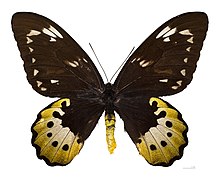
Swallowtail butterflies are large, colorful butterflies in the family Papilionidae, and include over 550 species. Though the majority are tropical, members of the family inhabit every continent except Antarctica. The family includes the largest butterflies in the world, the birdwing butterflies of the genus Ornithoptera.

The osmeterium is a defensive organ found in all papilionid larvae, in all stages. The organ is situated in the prothoracic segment and can be everted when the larva feels threatened. The everted organ resembles a fleshy forked tongue, and this along with the large eye-like spots on the body might be used to startle birds and small reptiles. The osmeterial organ remains inside the body in the thoracic region in an inverted position and is everted when the larva is disturbed in any way emitting a foul, disagreeable odor which serves to repel ants, small spiders and mantids. To humans, this odour is rather strong but not unpleasant, usually smelling like a concentrated scent of the caterpillar's food plant and pineapple.
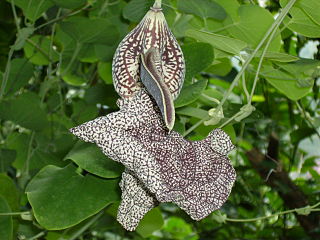
Aristolochia is a large plant genus with over 500 species that is the type genus of the family Aristolochiaceae. Its members are commonly known as birthwort, pipevine or Dutchman's pipe and are widespread and occur in the most diverse climates. Some species, like A. utriformis and A. westlandii, are threatened with extinction.
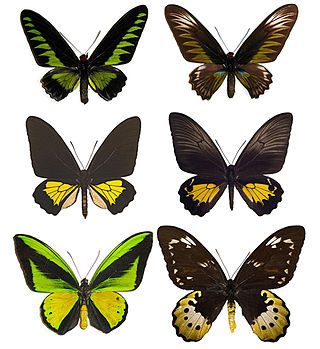
Birdwings are butterflies in the swallowtail family, that belong to the genera Trogonoptera, Troides, and Ornithoptera. Most recent authorities recognise 36 species, however, this is debated, and some authorities include additional genera. Birdwings are named for their exceptional size, angular wings, and birdlike flight. They are found across tropical Asia, mainland and archipelagic Southeast Asia, and Australasia.

Battus is a New World genus of butterflies that are usually found around pipevine plants. The caterpillars feed off the poisonous pipevines, making the insects poisonous themselves; they taste very bad to ward off predators. Since birds avoid these butterflies, other swallowtail species mimic their coloration. The common North American species are Battus polydamas and Battus philenor.

Battus philenor, the pipevine swallowtail or blue swallowtail, is a swallowtail butterfly found in North America and Central America. This butterfly is black with iridescent-blue hindwings. They are found in many different habitats, but are most commonly found in forests. Caterpillars are often black or red, and feed on compatible plants of the genus Aristolochia. They are known for sequestering acids from the plants they feed on in order to defend themselves from predators by being poisonous when consumed. The adults feed on the nectar of a variety of flowers. Some species of Aristolochia are toxic to the larvae, typically tropical varieties. While enthusiasts have led citizen efforts to conserve pipevine swallowtails in their neighborhoods on the West coast, the butterfly has not been the subject of a formal program in conservation or protected in legislation. The butterfly is however of "Special Concern" in Michigan, which is on the Northern limit of its range.

Byasa polyeuctes, the common windmill, is the most common member in India of the windmills genus (Byasa), comprising tailed black swallowtail butterflies with white spots and red submarginal crescents.

Red-bodied swallowtails, or ruby swallowtail (due to the color), are butterflies in the swallowtail family, that belong to the genera Atrophaneura, Byasa, Losaria, or Pachliopta. They are generally found in Asia.
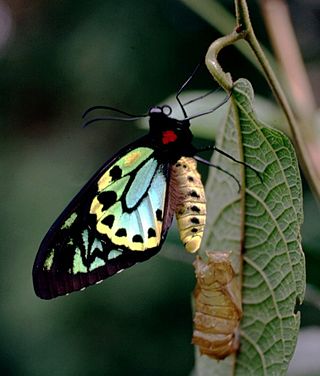
Ornithoptera richmondia, the Richmond birdwing, is a species of birdwing butterfly that is endemic to Australia. It is the second smallest of the birdwing species, the smallest being Ornithoptera meridionalis.
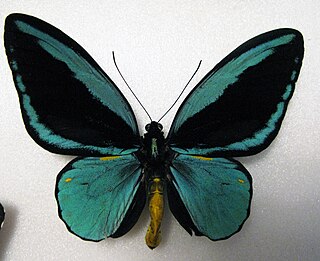
Ornithoptera aesacus, the Obi Island birdwing, is an extremely rare species of birdwing butterfly, endemic to the Island of Obira, Indonesia. While being a very rare species, they are commercially bred and traded.

Atrophaneura priapus, the Priapus batwing or white-head batwing, is a swallowtail butterfly found in Burma, Malaysia, Sumatra, and Java. The subspecies A. p. hageni was named to honour Hermann August Hagen. It may be a full species.

Troides cuneifera, the Mountain Birdwing, is a large butterfly belonging to the swallowtail family, Papilionidae, found in the Thai-Malay Peninsula, Sumatra, Java and Borneo.

Battus ingenuus, the Dyar's swallowtail or confused swallowtail, is a species of butterfly in the family Papilionidae.

Troides amphrysus, the Malay birdwing, is a birdwing butterfly in the genus Troides in the family Papilionidae.
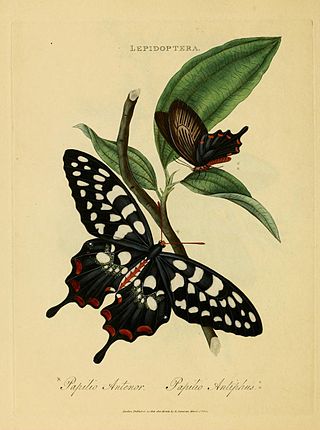
Pachliopta antiphus is a species of butterfly from the family Papilionidae (swallowtails) that is found in Sumatra, Borneo and the Philippines.
Byasa daemonius is a butterfly described by Sergei Alphéraky in 1895. It is found in Tibet and western China, that belongs to the windmills genus Byasa, comprising tailed black swallowtail butterflies with white spots and red submarginal crescents.
